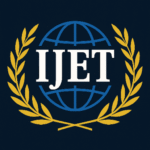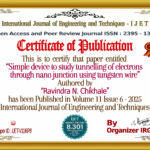
Integration and Performance Evaluation of LPWAN Protocols in Food Supply Chain Using NS2 Simulator | IJET – Volume 11 Issue 6 | IJET-V11I6P5

Table of Contents
ToggleInternational Journal of Engineering and Techniques (IJET)
Open Access • Peer Reviewed • High Citation & Impact Factor • ISSN: 2395-1303
Volume 11, Issue 6 | Published: November 2025
Author: Evelyn Serwaa Boateng , Dr. Twisha Shah , Aditya More , Dr. Kapil Kumar
Abstract
As proficiency carries on to progress and gain ground, cybersecurity continues to exist crucial in safeguarding digital devices and private data from cyber threats and attacks. Current advances in low-power wide area network (LPWAN) protocols have changed how information is gathered through Internet of Things (IoT) across food supply chain. The focus of the research is to bridge the identified gap by integrating LPWAN protocols into the NS2 simulator and evaluating their performance in the preview of food supply management. The study investigates how LPWAN protocols can enhance detection and supervision in food supply chain, using an NS2 simulator to implement and evaluate the performance. The study carried out by the simulations which were the most important. Some were energy consumption, latency, and packet delivery ratio. The revealed vital effect of the LPWAN protocol is the improved efficiency and reliability of data transmission in IoT-powered supply chain systems. This information is vital for the preference of the most suitable communication protocol for the advancement of the food supply chain. Despite challenges like coverage, low power consumption, and battery efficiency in IoT devices used in the food supply chain, Low-Power Wide Area Network (LPWAN) offers an affordable and energy-efficient solution. It provides extensive coverage, making it ideal for IoT systems that require long-range communication while ensuring efficient energy usage.
Keywords
Internet of Things, Network Simulation, Food Supply Chain, Packet Delivery Ratio, Latency, energy consumption
Conclusion
This study successfully integrated and evaluated LPWAN protocols using the NS2 simulator, demonstrating improved energy efficiency and reduced latency in food supply chain monitoring. The results highlight the significance of protocol selection in enhancing IoT network performance. The findings provide a baseline for future research on optimizing LPWAN-based food tracking systems. Future research can explore hybrid LPWAN models, integrate advanced blockchain protocols for enhanced data security, and simulate large-scale networks to validate performance under real-world conditions. Additionally, incorporating machine learning models could optimize resource management and anomaly detection within the network.
References
Mr. S. Gautam, Mr. P. Yadav, Mr. R. Thakur, Ms. R. pathak, and Mrs. S. Gupta, “Research Paper on Cyber Security,” Indian Scientific Journal Of Research In Engineering And Management, vol. 08, no. 10, pp. 1–6, Oct. 2024, doi: 10.55041/IJSREM38154.
[2] A. Dubey and S. K. Yadav, “Basics of Internet of Things,” Indian Scientific Journal Of Research In Engineering And Management, vol. 08, no. 10, pp. 1–6, Oct. 2024, doi: 10.55041/IJSREM37970.
[3] C. Meinert et al., “Food safety and food security through predictive microbiology tools: a short review,” Potravinarstvo, vol. 17, pp. 324–342, Mar. 2023, doi: 10.5219/1854.
[4] C. Igwebuike and A. Girma, “Analysis of Low-Power Wide-Area Network (LPWAN) Internet of Things (IoT) Telemetry System with Wireline Solution Approach Recommendation,” International Conference on Electrical, Computer, and Energy Technologies, ICECET 2024, pp. 1–6, Jul. 2024, doi: 10.1109/ICECET61485.2024.10698224.
[5] B. Xie et al., “LP-MAB: Improving the Energy Efficiency of LoRaWAN Using a Reinforcement-Learning-Based Adaptive Configuration Algorithm,” 2023, doi: 10.3390/s23042363.
[6] A. M. Al-Samman et al., “A Survey on LoRaWAN Technology: Recent Trends, Opportunities, Simulation Tools and Future Directions,” 2022, doi: 10.3390/electronics11010164.
[7] B. Tundys and T. Wiśniewski, “Benefit Optimization of Short Food Supply Chains for Organic Products: A Simulation-Based Approach,” Applied Sciences, vol. 10, no. 8, p. 2783, Apr. 2020, doi: 10.3390/APP10082783.
[8] Y. Wang, X.-Z. Gao, X. Xue, H. Alqurashi, F. Bouabdallah, and E. Khairullah, “SCAP SigFox: A Scalable Communication Protocol for Low-Power Wide-Area IoT Networks,” Sensors, vol. 23, no. 7, pp. 3732–3732, Apr. 2023, doi: 10.3390/S23073732.
[9] I. Drotar, B. Lukacs, and M. Kuczmann, “LoRaWAN Network Performance Test,” Acta Technica Jaurinensis, vol. 13, no. 4, pp. 268–280, Aug. 2020, doi: 10.14513/ACTATECHJAUR.V13.N4.547.
[10] C. Huang, Q. Chen, Z. Lin, W. Su, Z. Zhang, and S. Liu, “The Economic Impact and Application Challenges of IoT Technology in Smart Home and Infrastructure,” Journal of innovation and development, vol. 6, no. 1, pp. 35–39, Jan. 2024, doi: 10.54097/Y54JKP60.
[11] S. K. Pradhan and K. Shaw, “Internet of Things (IOT): Research Challenges and Future Applications,” Indian Scientific Journal Of Research In Engineering And Management, vol. 08, no. 07, pp. 1–12, Jul. 2024, doi: 10.55041/IJSREM36555.
[12] S. Kirmani, A. Mazid, I. A. Khan, and M. Abid, “A Survey on IoT-Enabled Smart Grids: Technologies, Architectures, Applications, and Challenges,” Sustainability, vol. 15, no. 1, pp. 717–717, Dec. 2022, doi: 10.3390/SU15010717.
[13] A. Mohammed Gaddafi and M. Muhammad, “Optimized Low-Powered Wide Area Network within Internet of Things,” Qeios, Aug. 2023, doi: 10.32388/FZQVZY.
[14] D. M. Namdev, “Review of: ‘Optimized Low-powered Wide Area Network within Internet of Things,’” May 2024, doi: 10.32388/2IJWK9.
[15] F. Loh, N. Mehling, and T. Hoßfeld, “Towards LoRaWAN without Data Loss: Studying the Performance of Different Channel Access Approaches,” Sensors, vol. 22, no. 2, pp. 691–691, Jan. 2022, doi: 10.3390/S22020691.
[16] C. Milarokostas, D. Tsolkas, N. Passas, and L. Merakos, “A Comprehensive Study on LPWANs With a Focus on the Potential of LoRa/LoRaWAN Systems,” IEEE Communications Surveys and Tutorials, vol. 25, no. 1, pp. 825–867, Jan. 2023, doi: 10.1109/COMST.2022.3229846.
[17] F. P. Correia, S. R. da Silva, F. B. S. de Carvalho, M. S. de Alencar, K. D. R. Assis, and R. M. Bacurau, “LoRaWAN Gateway Placement in Smart Agriculture: An Analysis of Clustering Algorithms and Performance Metrics,” Energies (Basel), vol. 16, no. 5, pp. 2356–2356, Mar. 2023, doi: 10.3390/EN16052356.
© 2025 International Journal of Engineering and Techniques (IJET).

Digital Object Identifier (DOI)
IJET assigns a unique DOI to every accepted article via Zenodo for persistent linking and citation. Your article’s DOI: https://doi.org/{{doi}}

Citations & Discovery
Citations are tracked via Google Scholar and DOI lookups. Use the links below to find where this article is cited.
- Google Scholar: Search Citations
- DOI Resolver: Open DOI





